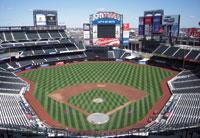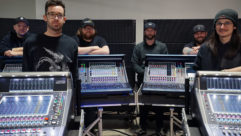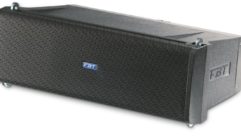

Stadium AV: Boys of Summer
As sure as Opening Day follows Spring Training, every year baseball stadiums seem to undergo AV upgrades. Perhaps more than any other AV experience, entertainment needs to keep pace with or exceed the in-home experience or risk losing customers.
Not that you sit there along the left field line, taking in a ball game on a warm summer evening, and think, “I wonder what went into this sound system” (maybe you do). But sure as Opening Day follows Spring Training, every year baseball stadiums seem to undergo AV upgrades. Perhaps more than any other AV experience, entertainment needs to keep pace with or exceed the in-home experience or risk losing customers. With household budgets as tight as they are, who will take in a game, or a movie, or a concert when they’ve got an HD plasma and surround-sound system in their family room?
This baseball season has been no different, with teams investing even more in AV gear, prolonging an escalating arms race to outdo one another (see “Mine’s Bigger Than Yours,” about stadium AV, at www.proavmagazine.com/stadiums). We rounded up the AV details of several 2009 upgrades to get an idea of where venues are spending their money.
The New York Mets’ Citi Field sports a new digital audio network and custom-tailored loudspeakers galore.
High Definition
For starters, Major League Baseball itself has spurred the need for high-definition content from every one of its 30 teams. The league recently launched its own network, MLB Network, and dispersed Panasonic AK-HC1500G high-definition cameras to all its stadiums to feed unique perspectives back to its production facility (rather than “the typical broadcast coverage,” according to Darrell Wenhardt of CBT in San Diego, who consulted on the project).
The multiformat 1080i/720p point-of-view cameras are controlled from Secaucus, N.J., where MLB Network uses a file-based digital workflow system to store all live video and audio–16 channels per video feed including metadata–in a shared storage area network and archive system. Editing suites have Grass Valley K2 Aurora and Final Cut Pro systems.
Oriole Park at Camden Yards. The home of the Baltimore Orioles, once the torch-bearer of new stadium design, had fallen behind the times technology-wise. A slew of AV pros, including from AVI-SPL, SIA Acoustics, and Communications Engineering (CEI), descended on the park and overhauled its sound and HD production systems.
AVI-SPL and SIA Acoustics put in a distributed sound reinforcement system with 300 EAW loudspeakers. SIA spec’d a variety of weather-protected loudspeaker for front-firing and down- and rear-fills throughout the stadium’s different seating areas, including EAW AX364-WP, MK2394-WP, and JFX100i models. The new sound system also sports an EAW UX8800 DSP, a BSS control system, 110 Crown Audio amplifiers, and a 48-channel Yamaha digital mixing console.
Oriole Park at Camden Yards
On the video side, CEI overhauled the park’s analog system to HD with everything from new Sony HDC1450 HD Triax portable cameras and control units and a Ross Vision 3 production switcher, to an Evertz routing system with integrated VIP-X Multi-viewer and Avid Deko 3000 HD character generator. The new system can originate HD programming and pipe it to the stadium’s new HD LED video displays over fiber-optic cables. It’s integrated with the HD broadcast trucks at Oriole Park, and with Major League Baseball’s own HD systems.
Kauffman Stadium, Kansas City. The Royals, which for the first time in a while have a team (or at least a pitcher) worth talking about, put video on the network. As the New York Yankees did in their new stadium, the Royals went with technology from IT giant Cisco Systems (the Toronto Blue Jays are also Cisco customers). The technology platform, which Cisco has dubbed StadiumVision, is basically an IPTV network built on Cisco gear (for more about the underlying technology, see our 5-Minute Interview with Cisco VP Thomas Wyatt at www.proavmagazine.com/wyatt). But it can also incorporate communications, wireless services, and other solutions that travel over IP.
In Kauffman Stadium, there are more than 400 IP-connected HDTVs that can show the game itself or any other content the team wants to stream, including digital signage advertising. According to Cisco, TVs in the suites have customized channels with statistics and lineups. When the game’s over, directions to exits and traffic information go to displays throughout the stadium.
Citi Field, New York. The new Mets stadium required AV systems from the ground up. Like at Oriole Park, the audio system married speakers from EAW with systems from Harman Pro. Integration was by St. Charles, Mo.-based TSI Global. Wrightson, Johnson, Haddon & Williams (WJHW) of Dallas did the design.
The CobraNet audio system comprises 160 Crown CTs 3000 amplifiers, along with 61 CTs 1200 and 19 CTs 2000 amps with PIP-Lite Modules for powering the main bowl speakers, club areas, suites, concession stands, bathrooms, and entrances. There’s also a litany of BSS Audio Soundweb London processors, including 20 BLU-120, 14 BLU-160, 10 BLU-80, and eight BLU-800 devices. The network, based on Harman’s HiQnet, was important for such an install because it afforded the integrator the flexibility to more easily configure systems in various parts of the stadium, according to TSI Global vice president Paul Murdick.
WJHW and TSI Global also went with more than 550 550 EAW MK and AX series loudspeakers. EAW officials say the company built a customized version of its full-range AX364-210 Arrayable Install Loudspeakers with a 60×40 horn, modified to fire simultaneously forward, down, and to the rear. “Those boxes are key to the overall consistency of the sound throughout the stadium, even in challenging locations,” says Murdick.
When you’re talking venues that seat 49,000, there are lots of challenges. At these and other sports stadiums, the drive to meet those AV challenges never seems to let up.










